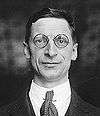Government of the 10th Dáil
The Government of the 10th Dáil or the 2nd Government of Ireland (30 June 1938 – 1 July 1943) was formed after the 1938 general election held on 17 June. It was a single-party Fianna Fáil government led by Éamon de Valera as Taoiseach. Fianna Fáil had been in office since the 1932 general election.
| Government of the 10th Dáil | |
|---|---|
| 2nd Government of Ireland | |
 | |
| Date formed | 30 June 1938 |
| Date dissolved | 1 July 1943 |
| People and organisations | |
| President | Douglas Hyde |
| Taoiseach | Éamon de Valera |
| Tánaiste | Seán T. O'Kelly |
| Total no. of ministers | 10 (1938–39) 12 (1939–43) |
| Member party | Fianna Fáil |
| Status in legislature | Majority Government |
| Opposition party | Fine Gael |
| Opposition leader | W. T. Cosgrave |
| History | |
| Election(s) | 1938 general election |
| Legislature term(s) | 10th Dáil |
| Predecessor | 1st Government |
| Successor | 3rd Government |
The 2nd Government lasted for 1,827 days.
2nd Government of Ireland
Nomination of Taoiseach
The members of the 10th Dáil first met on 30 June 1938. In the debate on the nomination of Taoiseach, Fianna Fáil leader and outgoing Taoiseach Éamon de Valera was proposed. The motion was approved by 75 to 45.[1] De Valera was then appointed as Taoiseach by President Douglas Hyde.[2] This was just five days after the inauguration of Hyde as the first President of Ireland on 25 June.
| 30 June 1938 Nomination of Éamon de Valera (FF) as Taoiseach[3] Motion proposed by Gerald Bartley and seconded by Bernard Maguire Absolute majority: 70/138 | ||
| Vote | Parties | Votes |
|---|---|---|
| Fianna Fáil (74), Independent (1) | 75 / 138 | |
| No | Fine Gael (44), Independent (1) | 45 / 138 |
| Absent or Not voting | Labour Party (9), Fianna Fáil (2), Fine Gael (1), Independents (5), Ceann Comhairle (1) | 19 / 138 |
Members of the Government
After his appointment as Taoiseach by the president, Éamon de Valera proposed the members of the government and they were approved by the Dáil.[4] They were then appointed by the president.
Constitutional amendments
During the first three years of the term of office of the first President of Ireland, the Oireachtas could pass amendments to the Constitution of Ireland without a referendum. This period lasted from 25 June 1938 to 24 June 1941. The First Amendment of the Constitution of Ireland was introduced and signed into law on 2 September 1939, allowing the Oireachtas to resolve that a state of emergency exists when an armed conflict exists outside of the state. The Emergency was declared on the same day, and the emergency powers lapsed on 2 September 1946. The Second Amendment of the Constitution of Ireland was signed into law on 30 May 1941 and was an omnibus amendment with 40 separate changes across the text of the Constitution. Both amendments were proposed by the Taoiseach.
See also
References
- "Election of Taoiseach – Dáil Éireann (10th Dáil) – Thursday, 30 June 1938". Houses of the Oireachtas. Retrieved 27 August 2019.
- "Appointment of Taoiseach – Dáil Éireann (10th Dáil) – Thursday, 30 June 1938". Houses of the Oireachtas. Retrieved 27 August 2019.
- "Election of Taoiseach – Votes – Dáil Éireann (10th Dáil) – Thursday, 30 June 1938". Houses of the Oireachtas. Retrieved 1 June 2020.
- "Nomination of Members of Government – Dáil Éireann (10th Dáil) – Thursday, 30 June 1938". Houses of the Oireachtas. Retrieved 27 August 2019.
- "Ceisteanna—Questions. Oral Answers. - Changes in the Ministry – Dáil Éireann (10th Dáil) – Wednesday, 27 September 1939". Houses of the Oireachtas. Retrieved 28 August 2019.
- "Nomination of Member of Government – Dáil Éireann (10th Dáil) – Wednesday, 27 September 1939". Houses of the Oireachtas. Retrieved 28 August 2019.